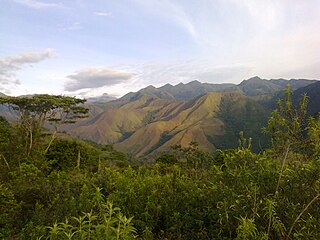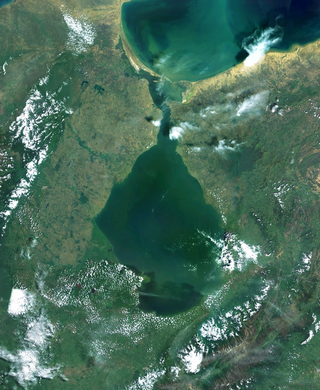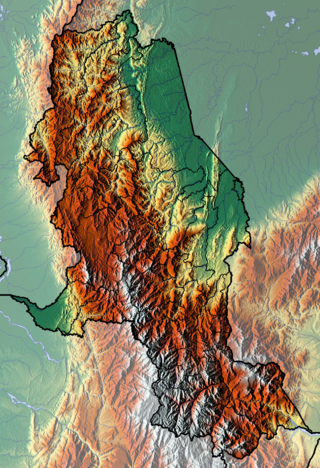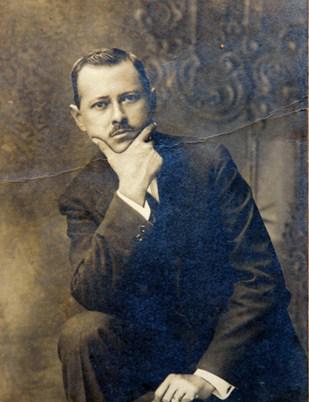
Zulia State is one of the 23 states of Venezuela. The state capital is Maracaibo. As of the 2011 census, it has a population of 3,704,404, the largest population among Venezuela's states. It is also one of the few states in Venezuela in which voseo is widespread. The state is coterminous with the eponymous region of Zulia.

Maracaibo is a city and municipality in northwestern Venezuela, on the western shore of the strait that connects Lake Maracaibo to the Gulf of Venezuela. It is the second-largest city in Venezuela, after the national capital, Caracas, and the capital of the state of Zulia. The population of the city is approximately 2,658,355 with the metropolitan area estimated at 5,278,448 as of 2010. Maracaibo is nicknamed "The Beloved Land of the Sun".

Lake Maracaibo is a brackish lake located in northwestern Venezuela, between the states of Zulia, Trujillo, and Mérida. Hydrologically, it is a semi-enclosed bay off the coast of the Gulf of Venezuela. Lake Maracaibo is commonly considered a lake, though due to its current geological characteristics, it should not be considered as such. With a surface area of 13,512 km2 (5,217 sq mi), it is the largest lake in South America and one of the oldest on Earth, having formed disputably as a lake 36 million years ago in the Andes Mountains.

The State of Mérida commonly known simply as Mérida is one of the 23 states of Venezuela. The state capital is Mérida, in the Libertador Municipality.

Trujillo State is one of the 23 states of Venezuela. Its capital is Trujillo and the largest city is Valera. The state is divided into 20 municipalities and 93 parishes. Trujillo State covers a total surface area of 7,198 km2 (2,779 sq mi) and, has a 2011 census population of 686,367.

Our Lady of the Rosary of Chiquinquirá or the Virgin of Chiquinquirá, popularly known in Venezuela as "La Chinita", is a Marian title of the Blessed Virgin Mary associated with a venerated image in the northern Andes region. She has been for centuries the highly appreciated patron saint of Colombia and adjacent regions of Venezuela, being the center of important traditional festivities at the beginning of Christmas, accompanied by local music.

Carúpano is a city in the eastern Venezuelan state of Sucre. It is located on the Venezuelan Caribbean coast at the opening of two valleys, some 120 km east of the capital of Sucre, Cumaná. This city is the shire town of the Bermúdez Municipality and, according to the 2010 Venezuelan census, the municipality has a population of 173,877 inhabitants. Carúpano is considered the gateway to the Paria Peninsula and its main commercial and financial center.

The Archdiocese of Maracaibo is an archdiocese in Venezuela. Since November 2000, its Archbishop has been Ubaldo Ramón Santana Sequera. The city of Maracaibo, the second largest in Venezuela, has a population of approximately 2,800,000. The Archdiocese covers a total area of 10,761 square kilometers in Zulia State.

Municipalities of Venezuela are subdivisions of the States of Venezuela. There are 335 municipalities dividing the 23 states and the Capital District.
Gaita zuliana is a style of Venezuelan folk music from Maracaibo, Zulia State. Dating as far back as the 1800s, gaitas began as improvised songs in the neighborhoods of Zulia where, as Robert T. Carroll describes, “people would gather in a circle and encourage each other to make up verses to a song." Gaita incorporates various instrumentations and rhythms from Spanish, Indigenous and African music. According to Joan Coromines, it may come from the word "gaits," the Gothic word for "goat", which is the skin generally used for the membrane of the furro drum. Other instruments used in gaita include maracas, cuatro, charrasca and tambora.

The department of Norte de Santander in northwestern Colombia, and its capital, Cúcuta, contains several rivers. The rivers are mostly part of the Maracaibo Lake basin, with the southeastern section located in the Magdalena River basin. Important fluvial elements are the Zulia, Catatumbo and Pamplonita Rivers. The entity in charge of taking care of these hydrology of Norte de Santander is Corponor.

Ciudad Ojeda is a city located in the northeastern shore of Lake Maracaibo in Zulia State in northwestern Venezuela. Its population as of the 2005 census was listed as 128,941.

Fernando Antonio Bermúdez Arias is one of Venezuela's most prolific doctor, cardiologist, scientist, writer, teacher, historian, artist and social defender. Born in San Cristobal – Tachira State, he spent most of his life in Maracaibo, Zulia State, Venezuela.
There have been four different professional baseball clubs in Venezuela that have played under the name Pastora. These teams have been established in the northwest of the country, particularly in the states of Zulia and Acarigua, and have played in different leagues between 1931 and 2000.
The Liga Occidental de Béisbol Profesional was a baseball circuit that operated between 1954 and 1963 in Maracaibo, the capital city in the Venezuela state of Zulia. The league played their games at the old olympic stadium of Maracaibo.

Costa Oriental del Lago de Maracaibo is a metropolitan area and subregion, that includes seven municipalities of Zulia state. It is the main traditional area of the oil industry in Zulia and where most oilfield operations are based. It's bordered to the west by Lake Maracaibo, the east with the states of Falcón and Lara, the north with the Gulf of Venezuela, and the south with Trujillo state. The "COL" conurbation has 758,957 inhabitants, while the "COL" as a subregion has 910,752 inhabitants.

Nora Bustamante Luciani was a Venezuelan physician, historian, writer and intellectual, who served as the president of the Venezuelan Association of the History of Medicine, the first woman to hold the post. For 16 years she was Director of the Historical Archive of Miraflores, a dependency of the Presidential Palace that preserves the history of the presidents of Venezuela.
An energy collapse in the state of Zulia, Venezuela occurred as a result of the country's ongoing general crisis, and it is the largest of its kind in the history of the state. With previous events in 2015 and 2016, the collapse intensified in 2017, when in September an alleged theft of cables left the city of Maracaibo and its surroundings without electricity. Since then long and short-term blackouts have been reported, which also cause the suspension of water supply, failures in cable television, telephone coverage and Internet access, among other services, as well as difficulty conducting business transactions, caused by the scarcity of banknotes and the dependence on the large-scale use of the point of sale terminals as well as electronic payments that are deficient in the absence of electricity and the Internet, resulting in closing of establishments, absence of work, damage of food and electrical appliances, the decrease in quality of life, among other factors, which added to the high temperatures suffered by citizens, affect the normal development of the population. Authorities such as the national government and the government of Zulia have attributed these failures to an alleged sabotage, but the opposition and experts denounce that it is due to lack of maintenance, also arguing that only less than half of what is consumed regularly is produced, reason for which there is "cargo administration" (rationing). The National Assembly of Venezuela, of opposition majority, declared the region in a state of electrical emergency. The service has also been interrupted but to a lesser extent in other states such as Bolívar, Carabobo, Falcón, Mérida, Miranda, Nueva Esparta, Táchira, Vargas and the country's capital Caracas.

Guillermo Trujillo Durán was a Venezuelan poet and politician. He is also remembered for his work in journalism and film, alongside his brother Manuel Trujillo Durán. He worked as editor for several Maracaibo-based publications and published some collections of poetry. In politics, he first served in the government of Zulia before entering the National Assembly, where he was Vice-President on two occasions.

San Francisco is a municipality in the metropolitan area of Maracaibo, Venezuela's second largest city. San Francisco covers an area of 185 square kilometres (71 sq mi) and recorded a population of 446,757 in the 2011 Venezuelan census.


















